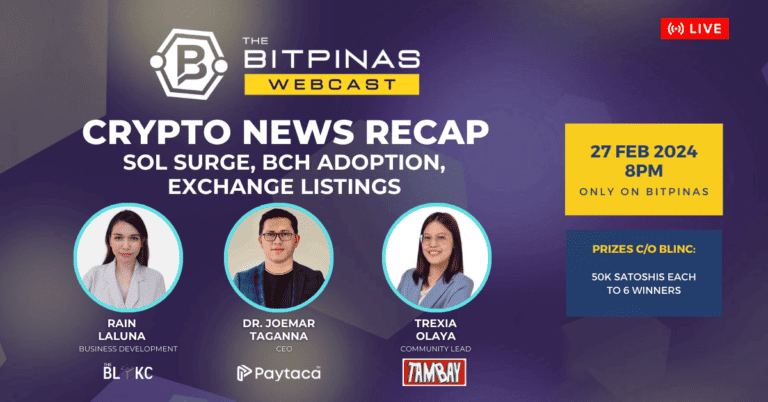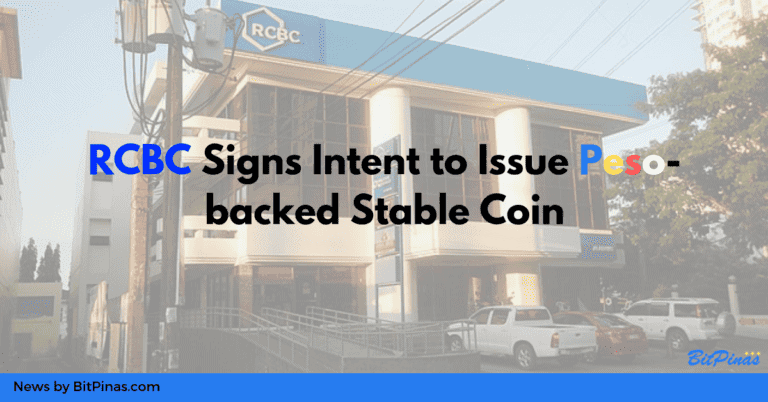How Web3 Founders Can Raise Funds Amid The Bear Market | BitPinas Webcast 29
This webcast is a can’t-miss opportunity for anyone involved in web3 who wants to understand the nuances of raising capital in less than favorable market conditions.

As the crypto winter settles in, web3 founders are seeking effective strategies to secure funding and sustain their projects through these turbulent times. In this BitPinas webcast, our third in the “Road to YGG Web3 Games Summit” series, we deep dive into fundraising during a bear market.
Table of Contents
We brought together two professionals in the blockchain venture space: Shi Khai Wei from LongHash Ventures and Yuji Kumagai from Emoote, who shed light on the dynamics of fundraising when the market sentiment is low and shared actionable insights on how to attract investment for web3 projects despite the downturn.
Watch the webcast here:
What You’ll Learn
- The current landscape of fundraising in web3 during a bear market.
- Strategies that web3 founders can employ to raise funds in challenging times.
- How venture firms are adapting their investment approaches with the market shift.
- The outlook of web3 investments and what this means for the future of blockchain projects.
Episode Recap
The bear market is the perfect opportunity to build web3 projects. According to BitPinas EIC Michael Mislos, those who became resilient during the crypto winter are usually the ones that prosper when the bull comes.
With this, the BitPinas Webcast has invited Yuji Kumagai, a general partner of Emoote, and Shi Khai Wei, the chief operating officer (COO) at LongHash Ventures, to tackle the strategies needed by web3-focused firms to raise funds in challenging times from the perspectives of venture executives during its 29th Episode, “How to Raise Funds Despite Bear Market.”
The episode is part of the series in preparation for the YGG Web3 Games Summit, one of the world’s premier web3 games events hosted by Yield Guild Games. It is happening from November 18 to 25, 2023 in multiple venues across Bonifacio Global City, Taguig, Philippines.
It includes a two-day conference, a three-day expo, a two-day tournament, a 24-hour hackathon, and dozens of both pre-events activities and side events across the business district.
Episode Notes
Venture Capital Funding As Described By Venture Capitalists
- Wei: Venture capital basically provides funding for founders. I would say there are some distinction between venture capital and other forms of capital. Because you might look at hedge funds, market makers or even exchanges, IDO (initial dex offering) platforms and so on. I think the difference with venture capital is that it tends to have a longer lifetime… I think the expectations are quite different compared to let’s say a hedge fund that maybe if you double their money, they’re very happy. I think for venture capital, we’re looking for adventurous size returns, which could mean 10 times 100 times 1000 times. So we’re looking for the most ambitious and therefore the highest growth potential in the space that we’re investing.
How does a venture capital firm decide to invest in a company?
- Wei: There are many factors that go into a decision on whether you invest. But if I may just kind of summarize it very briefly. What is the potential return? Like 100 to 1000 times and so on and secondly. With that promise, how likely are we to actually reach that potential? So we have to look at, do we have the right team set up, do we have the right product and positioning, do we already have some sort of traction that shows us the momentum and the potential that we can execute towards that potential vision?
- Wei: And I think lastly, (I) would be looking at the right timing and stage and the terms of the investment. So here’s where the market dynamics are quite important to look at the benchmarks of valuation and the co-investors of either from the previous round or the next round from the exit.
What are the typical stages of Funding?
- Kumagai: Mainly we prefer earlier stage from a seed stage. But in some cases, we cover more later stages. So the most important thing for us is teams, founders.
- Kumagai: I think the difference is in investment criteria. Who are the investors that you want and also what kind terms or how is the round structure? Are they all different by investment stage?
- Kumagai: Generally the first investment criteria, the earlier it is then the more important the team setup is. So when it’s early, it’s all about like “Do we have the right people that knows this problem really well?” and you can change your idea many times.
How the Bear Market Shaped Today’s Venture Capital
- Wei: Well, let me start off with checking. Are we still in the bear market? I think a significant portion of investors might feel that we are at the end of the bear market or maybe early bull market. But if you look at the volume of funding like in terms of absolute dollar amounts, we are still at the lows, compared to a couple of years ago in the bull market. So in that sense, definitely, we are not yet back into the full swing of the Bull.
- Wei: In the bear market, the best position that you could be in to take a opportunistic advantage is to be that project – the safe investment –- that everybody wants to be in because you are driving a lot of new innovation. Everyone’s talking about you and they’re imagining your future potential. Not everyone will be that project, but most importantly, keep making progress, keep building. We need to make progress.
Are there any geographic trends in web3 funding during this period, and how does the Philippines fare in this?
- Wei: So, there’s two sides to the answer. On one hand, crypto is fundamentally mostly digital and therefore by nature global. But at the same time, everybody has their own unique positioning. Be where you grew up, where you studied, where’s your network or where, what users that you’re targeting. So in that sense, certainly one way to focus is on particular geography, right?
- Wei: So of course if you have a very strong community or network or people from a particular country, they will love you. The main thing is we’ve seen huge adoption from the gaming sector, in particular Axie Infinity and YGG, and then from there branching off to other games and we also see that there’s a huge remittance sector as part of the economy. And therefore there is a natural use case for crypto for overseas payments or transfer and that’s why you can see things like GCash or like Coins.ph, these kind of startups doing well in the Philippines. So I would say that if you are focusing or if your stronghold or your base is a particular geography, then tap into the natural advantage and the user persona off that geography and win that market. And from there you can then go global.
- Kumagai: One of the biggest keyword is enterprise, especially Japanese or Korean enterprise, from the mobile game companies to the telecom companies or software hardware companies, they’re very aggressive to get in touch with web3 after the FTX collapse. So that would be the biggest chance in Asia perspectives. Probably, five years ago, the last cycle, there are no enterprise, there are only crypto native, right? It’s the biggest difference and where the biggest chance is.
- Wei: Actually there is one point we haven’t mentioned which is regulation and that is also very different by geography. So I think we’re all familiar that in the U.S., there’s a clamp down going on right now because the SEC sounds like very much against crypto. In Europe as well, there are a lot of regulations, although there’s some countries or some early signs that they’re trying to embrace crypto. By far Asia seems to be right now the friendliest in terms of regulation to crypto. Hong Kong just allowed license to retail exchanges, Singapore continues to grant licenses for exchange. I think in the Philippines, crypto is still ongoing, and in Japan also we have now more licensed exchanges like more tokens getting listed.
Tips on Strategies for Web3 Founders to Fundraise
- Wei: So first of all, we should understand our situation and market condition. And you should also talk with many community members. For example, there are some other voices that are investors, and to give your pitch to those potential investors or your partners members.
- Wei: Now whether or not you should change your business model and let’s say, ‘I have one product and now maybe I go after a different product, Maybe I just do some product consulting projects, advisory projects just to get some cash in and then that that seems to be the more like emergency tactics to deal with it’ I would say that as long as you are making progress in terms of understanding your market and understanding your users and what eventual product that you can that you’re gonna make, it’s totally okay.
How are venture firms currently supporting their portfolio companies through the downturn?
- Kumagai: I think everybody has their own unique flavor of value add. For us, we run an accelerator alongside the fund. So if we invest in an infrastructure for a community or a platform, what we can do is help bootstrap the ecosystem by helping some of the early stage founders who are thinking of integrating with your product or community or infrastructure turn their idea into a long term sustainable project by letting them come through the accelerator program. So we firstly invest and then we attract other investors to come and invest forward accelerated projects.
Advise on Web3 Founders for the Upcoming Bull Run
- Kumagai: First of all, you can focus on the product, not on token price. You can focus on product development or community building. Also, one of the biggest hands-on task is their (community) mental support.
- Wei: There’s one main thing I will add, which is to pay attention to what is going to be different in this next cycle compared to the previous cycle. What is different and what will change the whole industry. So one answer that is very clear is that the infrastructure and apps. As our infrastructure and the tools that you’re gonna use is going to be very different and it’s going to transform the user experience for the next generation applications.
- Wei: So now we have L2 blockchains, we have onchain apps, we have L3s, so now you can have cheap and fast transactions, you can be completely gasless. So pay attention because these are completely new infrastructure that enables new possibilities for you in the next bull cycle.
- Wei: Of course next is that take full advantage of that. So if there are new users coming in new channels, new partners definitely go ahead and make full use of those. I think there’s so much new attention they’re gonna get from media from new projects. Some new communities that spring up. This is the best time to maximize your reach and impact. And I would say lastly, make sure to don’t end up in jail. Be careful to preserve reputation, because when the bear market comes, or like in the years to come, your token holders, your investors, the people in industry, they will remember you by what you have done.”
Watch or Read other webcast episodes here
This article is published in BitPinas: How Web3 Founders Can Raise Funds Amid The Bear Market | BitPinas Webcast 29
Disclaimer:
- Before investing in any cryptocurrency, it is essential that you carry out your own due diligence and seek appropriate professional advice about your specific position before making any financial decisions.
- BitPinas provides content for informational purposes only and does not constitute investment advice. Your actions are solely your own responsibility. This website is not responsible for any losses you may incur, nor will it claim attribution for your gains.













